General Description
Body deep, compressed; dorsal fin long based; scales covering space between the eyes; jaws with peg-like teeth at the front and molars at the rear. Adults develop a hump-headed appearance with age. Silvery-pink to pinkish-red with small bright blue spots. To 1.3 m.
Biology
Snapper is Victoria's most popular recreational finfish. Juveniles settle in seagrass beds and move into rocky areas as they grow. Adults roam freely, occasionally migrating out of the bay.
Habitat
Widespread on rocky reefs in bays and along the coast, in depths of 0-200 m.
Reefs
Distribution guide
New Zealand and Australia.
Species Group
Depth
Shallow (1-30 m)
Deep ( > 30 m)
Water Column
Max Size
1.3 m
Commercial Species
Yes
Global Dispersal
Recorded in Australia
Conservation Status
- DSE Advisory List : Not listed
- EPBC Act 1999 : Not listed
- IUCN Red List : Not listed





